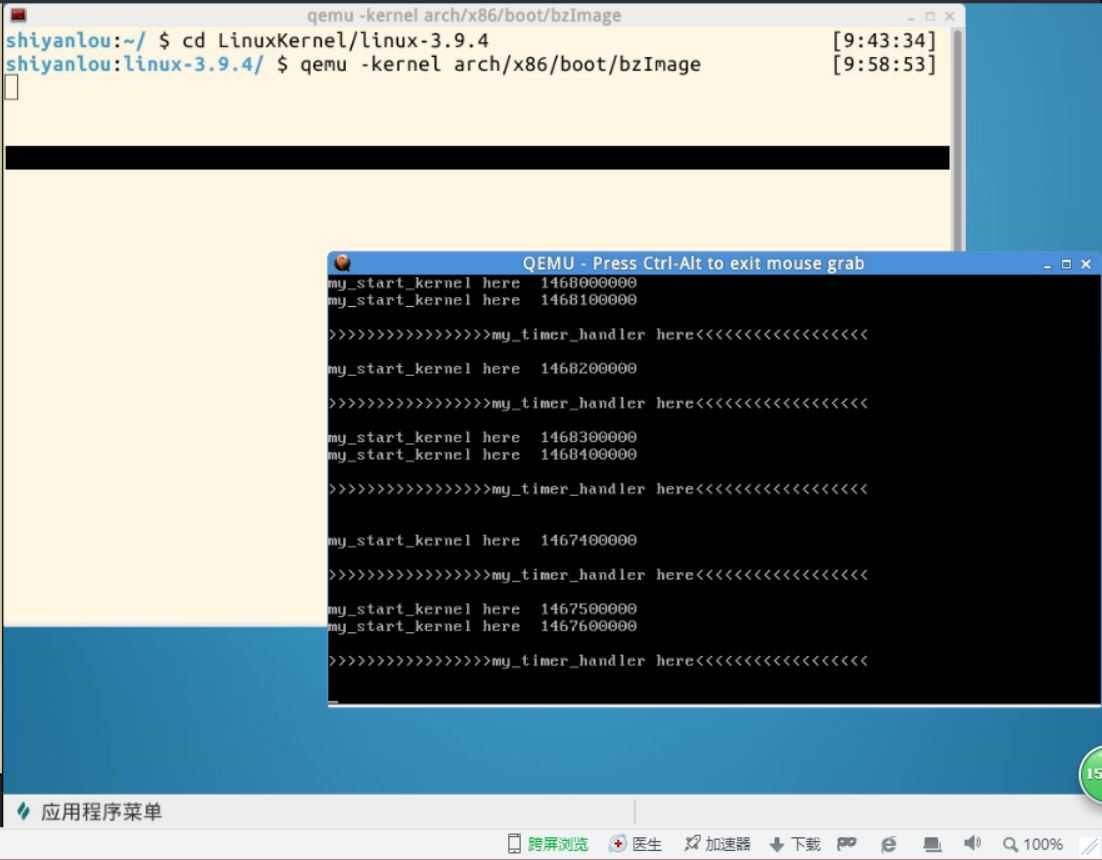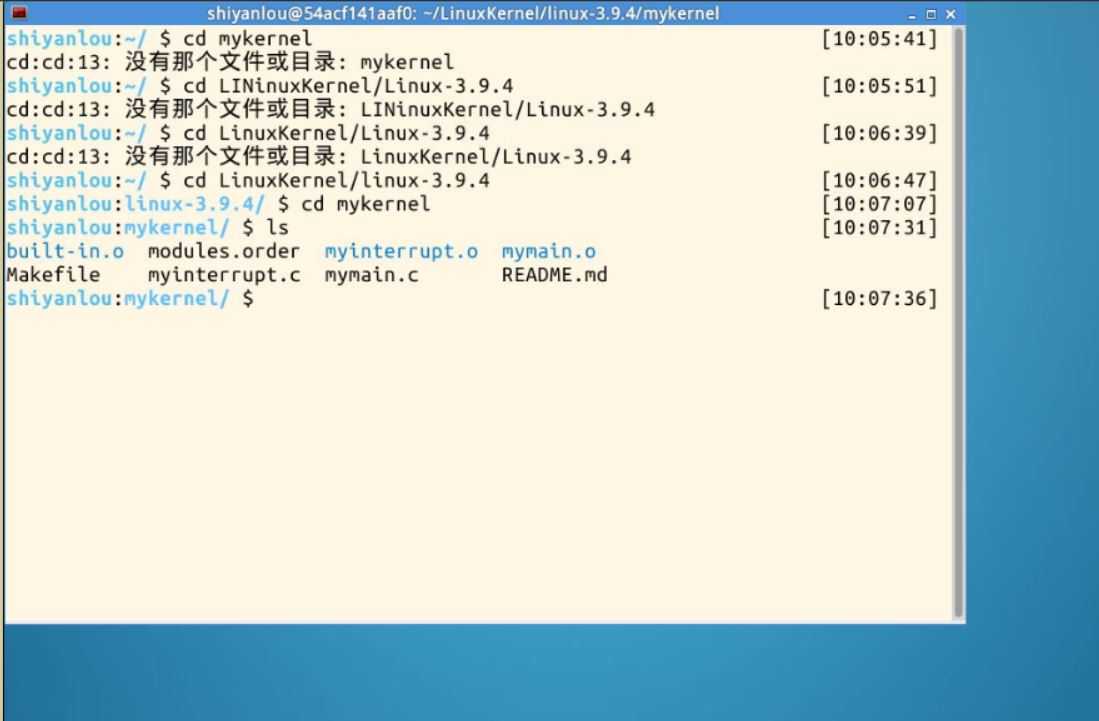标签:
作者:20135336 王维臻
《Linux内核分析》MOOC课程http://mooc.study.163.com/course/USTC-1000029000
一、实验过程
cd LinuxKernel/linux-3.9.4 qemu -kernel arch/x86/boot/bzImage
然后cd mykernel 您可以看到qemu窗口输出的内容的代码mymain.c和myinterrupt.c


1.mymain.c代码
/* * linux/mykernel/myinterrupt.c * * Kernel internal my_timer_handler * * Copyright (C) 2013 Mengning * */ #include <linux/types.h> #include <linux/string.h> #include <linux/ctype.h> #include <linux/tty.h> #include <linux/vmalloc.h> #include "mypcb.h" extern tPCB task[MAX_TASK_NUM]; extern tPCB * my_current_task; extern volatile int my_need_sched; volatile int time_count = 0; /* * Called by timer interrupt. * it runs in the name of current running process, * so it use kernel stack of current running process */ void my_timer_handler(void) { #if 1 if(time_count%1000 == 0 && my_need_sched != 1) { printk(KERN_NOTICE ">>>my_timer_handler here<<<\n"); my_need_sched = 1; } time_count ++ ; #endif return; } void my_schedule(void) { tPCB * next; tPCB * prev; if(my_current_task == NULL || my_current_task->next == NULL) { return; } printk(KERN_NOTICE ">>>my_schedule<<<\n"); /* schedule */ next = my_current_task->next; prev = my_current_task; if(next->state == 0)/* -1 unrunnable, 0 runnable, >0 stopped */ { /* switch to next process */ asm volatile( "pushl %%ebp\n\t" /* save ebp */ "movl %%esp,%0\n\t" /* save esp */ "movl %2,%%esp\n\t" /* restore esp */ "movl $1f,%1\n\t" /* save eip */ "pushl %3\n\t" "ret\n\t" /* restore eip */ "1:\t" /* next process start here */ "popl %%ebp\n\t" : "=m" (prev->thread.sp),"=m" (prev->thread.ip) : "m" (next->thread.sp),"m" (next->thread.ip) ); my_current_task = next; printk(KERN_NOTICE ">>>switch %d to %d<<<\n",prev->pid,next->pid); } else { next->state = 0; my_current_task = next; printk(KERN_NOTICE ">>>switch %d to %d<<<\n",prev->pid,next->pid); /* switch to new process */ asm volatile( "pushl %%ebp\n\t" /* save ebp */ "movl %%esp,%0\n\t" /* save esp */ "movl %2,%%esp\n\t" /* restore esp */ "movl %2,%%ebp\n\t" /* restore ebp */ "movl $1f,%1\n\t" /* save eip */ "pushl %3\n\t" "ret\n\t" /* restore eip */ : "=m" (prev->thread.sp),"=m" (prev->thread.ip) : "m" (next->thread.sp),"m" (next->thread.ip) ); } return; }
每循环十万次打印一个printk(KERN_NOTICE "my_start_kernel here %d \n",i);
2.myinterrupt.c代码
/*
* linux/mykernel/myinterrupt.c
*
* Kernel internal my_timer_handler
*
* Copyright (C) 2013 Mengning
*
*/
#include <linux/types.h>
#include <linux/string.h>
#include <linux/ctype.h>
#include <linux/tty.h>
#include <linux/vmalloc.h>
#include "mypcb.h"
extern tPCB task[MAX_TASK_NUM];
extern tPCB * my_current_task;
extern volatile int my_need_sched;
volatile int time_count = 0;
/*
* Called by timer interrupt.
* it runs in the name of current running process,
* so it use kernel stack of current running process
*/
void my_timer_handler(void)
{
#if 1
if(time_count%1000 == 0 && my_need_sched != 1)
{
printk(KERN_NOTICE ">>>my_timer_handler here<<<\n");
my_need_sched = 1;
}
time_count ++ ;
#endif
return;
}
void my_schedule(void)
{
tPCB * next;
tPCB * prev;
if(my_current_task == NULL
|| my_current_task->next == NULL)
{
return;
}
printk(KERN_NOTICE ">>>my_schedule<<<\n");
/* schedule */
next = my_current_task->next;
prev = my_current_task;
if(next->state == 0)/* -1 unrunnable, 0 runnable, >0 stopped */
{
/* switch to next process */
asm volatile(
"pushl %%ebp\n\t" /* save ebp */
"movl %%esp,%0\n\t" /* save esp */
"movl %2,%%esp\n\t" /* restore esp */
"movl $1f,%1\n\t" /* save eip */
"pushl %3\n\t"
"ret\n\t" /* restore eip */
"1:\t" /* next process start here */
"popl %%ebp\n\t"
: "=m" (prev->thread.sp),"=m" (prev->thread.ip)
: "m" (next->thread.sp),"m" (next->thread.ip)
);
my_current_task = next;
printk(KERN_NOTICE ">>>switch %d to %d<<<\n",prev->pid,next->pid);
}
else
{
next->state = 0;
my_current_task = next;
printk(KERN_NOTICE ">>>switch %d to %d<<<\n",prev->pid,next->pid);
/* switch to new process */
asm volatile(
"pushl %%ebp\n\t" /* save ebp */
"movl %%esp,%0\n\t" /* save esp */
"movl %2,%%esp\n\t" /* restore esp */
"movl %2,%%ebp\n\t" /* restore ebp */
"movl $1f,%1\n\t" /* save eip */
"pushl %3\n\t"
"ret\n\t" /* restore eip */
: "=m" (prev->thread.sp),"=m" (prev->thread.ip)
: "m" (next->thread.sp),"m" (next->thread.ip)
);
}
return;
}
每次时钟中断都调用一次printk(),printk(KERN_NOTICE "\n>>>>>>>>>>>>>>>>>my_timer_handler here<<<<<<<<<<<<<<<<<<\n\n");
二、学习内容
(一)计算机是如何工作的?
1.存储程序计算机工作模型,计算机系统最最基础性的逻辑结构;
2.函数调用堆栈,高级语言得以运行的基础,只有机器语言和汇编语言的时候堆栈机制对于计算机来说并不那么重要,但有了高级语言及函数,堆栈成为了计算机的基础功能;
enter :pushl %ebp
movl %esp,%ebp
leave :movl %ebp,%esp
popl %ebp
函数参数传递机制和局部变量存储
标签:
原文地址:http://www.cnblogs.com/20135336wwz/p/5246693.html